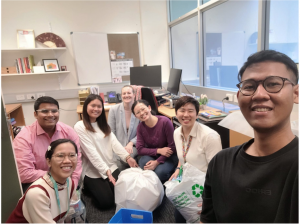
When the Classroom Gets Heavy: Finding Hope Amid Crisis

Dr Connie Gan
Griffith Institute for Human and Environmental Resilience (GIHER)
School of Medicine and Dentistry, Griffith University
Walking out after watching the documentary “Corals’ Last Stand” and conversations with frontline activists, I felt my heart sink with a mix of emotions. Ongoing proposals to continue destructive practices like seismic blasting, gas flaring, and drilling, threatens reefs that shelter endangered turtles, sea snakes, and blue whales. Billions of tonnes of emissions heating our oceans and bleaching corals. And yep, it’s making climate change and health worse.
deep breath
“How did we let it get this bad?” “What’s the point of learning about this if it’s already too late?” These are questions I often hear in the classroom.
As an early career academic teaching environmental/planetary health health, I often find myself in this uncomfortable position, showing students the reality of our ecological crisis while trying not to completely crush their spirits. It’s a delicate balance, and honestly, some days I don’t get it right.
Reactions from the audience after the documentary mirrored what I see in the classroom: anger, fear, disappointment, and sometimes a profound sense of helplessness.
Learning and teaching activities on this topic not just transferring knowledge, but processing grief together. Facing fear together. And often, we’re sitting with fury together. I’m learning alongside my students, often struggling and navigating with the same emotions they are.
Students react intensely to environmental tragedies like Chernobyl and energy-versus-environment debates. Rather than rushing to offer solutions, I’m learning to validate their emotions as appropriate responses to difficult information. These feelings aren’t obstacles to learning; they’re an important part of learning. Collectively facing these hard truths may be our most meaningful learning outcome.
Finding Hope in Action
Connecting With Nature. Make it Personal. One approach I’ve found helpful is bringing nature into our classroom. Invite students to use iNaturalist for campus observations, set up booths in community eco-action festivals. There’s something powerful about spending time in nature, feeling the breeze on your face and learning about your non-human neighbours and surroundings. I invite students to share their personal connections with the environment. “What’s your happy place? Which landscapes shaped your childhood?” These stories transform abstract concepts into lived experiences. Last trimester, one student shared about her dad, a veteran exposed to Agent Orange during the Vietnam War. That single story taught us more about climate justice than any textbook could.
Celebrate Legal and Advocacy Victories. As 2025 World Environmental Health Day (September 26) approaches with its “Clean Air, Healthy People” theme, recent legal victories offer hope. The “Ella case” recognised air pollution’s role in a child’s death, establishing groundwork for public health action. Other examples, the International Court of Justice’s ruling was conceived by law students from the Pacific, clarifying states’ legally bound to cut their emissions and compensate those already suffering the consequences. In April 2024, KlimaSeniorinnen, a group of Swiss senior women, won at the European Court of Human Rights, which ruled Switzerland’s inadequate climate policies violated their human rights by increasing their vulnerability to climate impacts like heatwaves.
Small Actions. Meaningful Engagement. Will watching a 30-minute documentary solve coral reef bleaching or reverse global warming? Probably not. But it might help us practice the advocacy skills, civic engagement, and community-building connections that real solutions require. I’m learning alongside my students and educators from CAPHIA / Planetary Health Alliance. I don’t have all the answers, far from it. But I’m working towards creating learning spaces where we can face difficult truths together, honour our emotional responses, and practice moving from awareness into action.
And the distinction matters: Teaching about planetary health versus teaching for it represents a world of difference.
What’s your thoughts? I’d love to hear them, please join us at our CAPHIA-ECA September catch-up café!